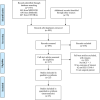Hydroxyethyl starch 130/0.4 for volume replacement therapy in surgical patients: a systematic review and meta-analysis of randomized controlled trials
- PMID: 33971968
- PMCID: PMC8111748
- DOI: 10.1186/s13741-021-00182-8
Hydroxyethyl starch 130/0.4 for volume replacement therapy in surgical patients: a systematic review and meta-analysis of randomized controlled trials
Abstract
Background: The safety of perioperative intravenous hydroxyethyl starch (HES) products, specifically HES 130/0.4, continues to be the source of much debate. The aim of this meta-analysis was to update the existing evidence and gain further insight into the clinical effects of HES 130/0.4 on postoperative outcomes for volume replacement therapy in surgical patients.
Methods: MEDLINE, EMBASE, and Cochrane Library databases were searched from inception to March 2020 for relevant randomized controlled trials (RCTs) on perioperative use of HES 130/0.4 in adult surgical patients. The primary outcome was postoperative mortality and secondary outcomes were the incidence of acute kidney injury (AKI) and requirement for renal replacement therapy (RRT). The analysis was performed using the random-effects method and the risk ratio (RR) with a 95% confidence interval (CI). We performed the risk-of-bias assessment of eligible studies and assessed the overall quality of evidence for each outcome.
Results: Twenty-five RCTs with 4111 participants were finally included. There were no statistical differences between HES 130/0.4 and other fluids in mortality at 30 days (RR 1.28, 95% CI 0.88 to 1.86, p = 0.20), the incidence of AKI (RR 1.23, 95% CI 0.99 to 1.53, p = 0.07), or requirement for RRT (RR 0.75, 95% CI 0.37 to 1.53, p = 0.43). Overall, there was a moderate certainty of evidence for all the outcomes. There was no subgroup difference related to the type of surgery (p = 0.17) in the incidence of AKI. As for the type of comparator fluids, however, there was a trend that was not statistically significant (p = 0.06) towards the increased incidence of AKI in the HES 130/0.4 group (RR 1.22, 95% CI 0.97 to 1.54) compared with the crystalloid group (RR 1.21, 95% CI 0.27 to 3.91). Subgroup analyses according to the type of surgery demonstrated consistent findings.
Conclusions: This systematic review and meta-analysis suggests that the use of HES 130/0.4 for volume replacement therapy compared with other fluids resulted in no significant difference in postoperative mortality or kidney dysfunction among surgical patients. Given the absent evidence of confirmed benefit and the potential trend of increased kidney injury, we cannot recommend the routine clinical use of HES 130/0.4 for volume replacement therapy in surgical patients from the perspective of benefit/risk profile. However, the results need to be interpreted with caution due to the limited sample size, and further well-powered RCTs are warranted.
Trial registration: PROSPERO registry reference: CRD42020173058.
Keywords: Hydroxyethyl starch 130/0.4; Surgery; Volume replacement therapy.
Conflict of interest statement
The authors declare that they have no competing interests.
Figures





Similar articles
-
Hydroxyethyl Starch for Fluid Management in Patients Undergoing Major Abdominal Surgery: A Systematic Review With Meta-analysis and Trial Sequential Analysis.Anesth Analg. 2022 Apr 1;134(4):686-695. doi: 10.1213/ANE.0000000000005803. Anesth Analg. 2022. PMID: 34854822
-
Hydroxyethyl starch for fluid resuscitation in critically ill patients.Can J Anaesth. 2013 Jul;60(7):709-13. doi: 10.1007/s12630-013-9936-4. Epub 2013 Apr 20. Can J Anaesth. 2013. PMID: 23604905
-
Early versus late initiation of renal replacement therapy in patients with acute kidney injury-a systematic review & meta-analysis of randomized controlled trials.BMC Nephrol. 2017 Feb 28;18(1):78. doi: 10.1186/s12882-017-0486-9. BMC Nephrol. 2017. PMID: 28245793 Free PMC article.
-
Hydroxyethyl starch versus other fluids for non-septic patients in the intensive care unit: a meta-analysis of randomized controlled trials.Crit Care. 2015 Mar 19;19(1):92. doi: 10.1186/s13054-015-0833-9. Crit Care. 2015. PMID: 25886952 Free PMC article.
-
Renal Morbidity of 6% Hydroxyethyl Starch 130/0.4 in 9000 Propensity Score Matched Pairs of Surgical Patients.Anesth Analg. 2020 Jun;130(6):1618-1627. doi: 10.1213/ANE.0000000000004592. Anesth Analg. 2020. PMID: 31856004 Free PMC article.
Cited by
-
A Critical Reassessment of the Kidney Risk Caused by Tetrastarch Products in the Perioperative and Intensive Care Environments.J Clin Med. 2023 Aug 12;12(16):5262. doi: 10.3390/jcm12165262. J Clin Med. 2023. PMID: 37629303 Free PMC article. Review.
-
The role of hydroxyethyl starch in perioperative acute kidney injury. Comment on Br J Anaesth 2024; 133: 1263-75.Br J Anaesth. 2025 Mar;134(3):862-864. doi: 10.1016/j.bja.2024.11.037. Epub 2025 Jan 18. Br J Anaesth. 2025. PMID: 39826990 Free PMC article. No abstract available.
-
Enhancing the Treatment of Uncontrolled Inflammation through the Targeted Delivery of TPCA-1-Loaded Nanoparticles.Pharmaceutics. 2023 Oct 9;15(10):2435. doi: 10.3390/pharmaceutics15102435. Pharmaceutics. 2023. PMID: 37896195 Free PMC article.
References
-
- Bellomo R, Ronco C, Kellum JA, Mehta RL, Palevsky P, Acute Dialysis Quality Initiative workgroup Acute renal failure - definition, outcome measures, animal models, fluid therapy and information technology needs: the Second International Consensus Conference of the Acute Dialysis Quality Initiative (ADQI) Group. Crit Care. 2004;8:R204–R212. doi: 10.1186/cc2872. - DOI - PMC - PubMed
-
- Brunkhorst FM, Engel C, Bloos F, Meier-Hellmann A, Ragaller M, Weiler N, et al. Intensive insulin therapy and pentastarch resuscitation in severe sepsis. N Engl J Med. 2008;358(2):125–39. 10.1056/NEJMoa070716. - PubMed
Publication types
LinkOut - more resources
Full Text Sources
Other Literature Sources
Medical
Research Materials

